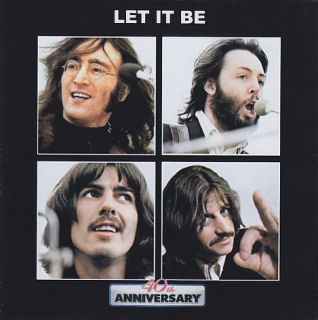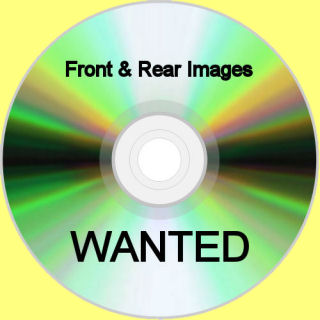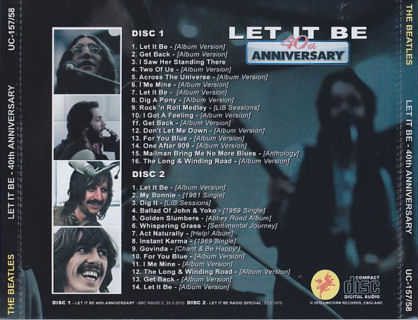Let It Be - 40th Anniversary

Cover


Let It Be - 40th Anniversary |
||
 |
||
Cover |
||
 |
 |
|
Disc (top/matrix) |
Rear Tray (back/inner) |
|
Let It Be - 40th Anniversary 25.05. 2010 BBC Radio 2 To mark the 40th anniversary of the release of Let It Be, and the accompanying Academy Award-winning film [both released in May 1970], Guy Garvey tells the story of the fractious and often bitter sessions that documented the demise of The Beatles. Featuring contributions from many of those who worked on the Let It Be sessions, including director Michael Lindsay-Hogg, engineer Alan Parsons, photographer Ethan Russell, author Richard DiLello and engineers Dave Harries and Brian Gibson, this programme explains how a project [originally a TV documentary, titled Get Back, which was designed to re-energise the band and capture their stripped down rock'n'roll roots], instead documented power struggles, bickering and conflict. The project was perhaps doomed from the start. Paul McCartney's original suggestion was for the group to play three shows, which he hoped would refocus and invigorate the band after the tensions experienced during the recording of the White Album. When this plan failed to materialise, the idea evolved into a worldwide broadcast of a live concert. Paul decided that the rehearsals should be filmed for a documentary that would promote the live broadcast and they began at Twickenham Studios on 2 January 1969. Everyone involved in the rehearsals considered them to be disastrous. Harrison was increasingly resentful because he felt his songs were either derided or ignored; Paul's attempts to hold the band together and rally spirits came across as controlling; John had all but withdrawn creatively, seldom contributing even to the arrangements of his own songs; and Yoko Ono - who often spoke on John's behalf as he sat silently by - was a major source of tension.The intrusive film cameras and the cold, unfamiliar settings of Twickenham Studios contributed to the ill feeling. Fed up with John's creative and communicative disengagement, George announced that he was leaving the band. He went to Eric Clapton's house, where he wrote Here Comes The Sun, but within a few days he was persuaded to return to the group. After three weeks of filming, the band were still unable to agree on a location for the proposed concert, so Michael Lindsay-Hogg suggested they stage an impromptu performance on the rooftop of their Apple headquarters. The live performance took place on 30 January in front of a small audience of friends and employees but it was short by the police after complaints about noise. Filming continued the following day and then no further work was carried out on the project until March, when John and Paul called engineer Glyn Johns to EMI and offered him free rein to produce an album from the recordings. John booked time at Olympic Studios to mix the album and pres-ented it to the group at the end of May. Originally intended for release in July 1969, it was pushed back to September, to coincide with the TV special and film about the making of the album, and then further delayed because the band decided to release Abbey Road instead. On 15 December, Glyn Johns was approached again, but this time with the instruction that the songs must match those included in the [as yet unreleased] film. New mixes were prepared but once again rejected. Then in March 1970, the session tapes were given to American producer Phil Spector, who worked on the tracks and compiled Let It Be. By the time the album and the film with the same name were finally released on 8 May 1970, the Beatles had broken up. Let It Be Radio Special - May 1970 Shortly after the first release of the Let It Be album in May 1970 a radio show was aired presented by Australian DJ Johhny Moran.The show compiled a mixture of tracks from the album along with Interviews from the individual Beatles. Thrown into the show were early tracks of The Beatles plus solo efforts from John, George and Ringo. An early airing of a more complete song from the Let It Be Sessions “Dig It”, only captured in partial form on the Album, although at the time only available complete on some early bootleg albums from 1969. What’s captured here [although in low-fi quality] is a historical document of an early airing of what became The Beatles last album Let It Be. |
| Let It Be - 40th Anniversary - BBC Radio 2 25 May 2010 |
|||||
| Song | Version | Comments | Date | ||
| 1 | Let It Be | Album Version | |||
| 2 | Get Back | Album Version | |||
| 3 | I Saw Her Standing There | Album Version | |||
| 4 | Two Of Us | Album Version | |||
| 5 | Across The Universe | Album Version | |||
| 6 | I Me Mine | Album Version | |||
| 7 | Let It Be | Album Version | |||
| 8 | I Me Mine | Album Version | |||
| 9 | Rock 'n Roll Medley | GB | |||
| 10 | I Got A Feeling | Album Version | |||
| 11 | Get Back | Album Version | |||
| 12 | Don't Let Me Down | Album Version | |||
| 13 | For You Blue | Album Version | |||
| 14 | One After 909 | Album Version | |||
| 15 | Mailman Bring Me No More Blues | Anthology | |||
| 16 | The Long & Winding Road | Album Version | |||
 |
 |
Disc 1 |
Disc 2 |
| Let It Be Radio Special - Unknown Channel May 1970 |
|||||
| Song | Version | Comments | Date | ||
| 1 | Let It Be | Album Version | |||
| 2 | My Bonnie | 1961 Single | |||
| 3 | Dig It | LIB Sessions | |||
| 4 | Ballad Of John & Yoko | 1969 Single | |||
| 5 | Golden Slumbers | Abbey Road Album | |||
| 6 | Whispering Grass | Sentimental Journey | |||
| 7 | Act Naturally | Help! Album | |||
| 8 | Instant Karma | 1969 Single | |||
| 9 | Govinda | Chant & Be Happy! | |||
| 10 | For You Blue | Album Version | |||
| 11 | I Me Mine | Album Version | |||
| 12 | The Long & Winding Road | Album Version | |||
| 13 | Get Back | Album Version | |||
| 14 | Let It Be | Album Version | |||
|
Gatefold Cover |
Inner Art |
Booklet |
Inner Tray Art |
Comment |
|
Y |
Y |
N |
Y |
The collated information is from hundreds of sources, I am unable to verify the accuracy of any information implied or provided .
I neither own these discs or know how to
obtain them , so any Corrections or New material is always appreciated.
This page is a working document, last updated on the 26-May-2012
HOME |
LABELS |